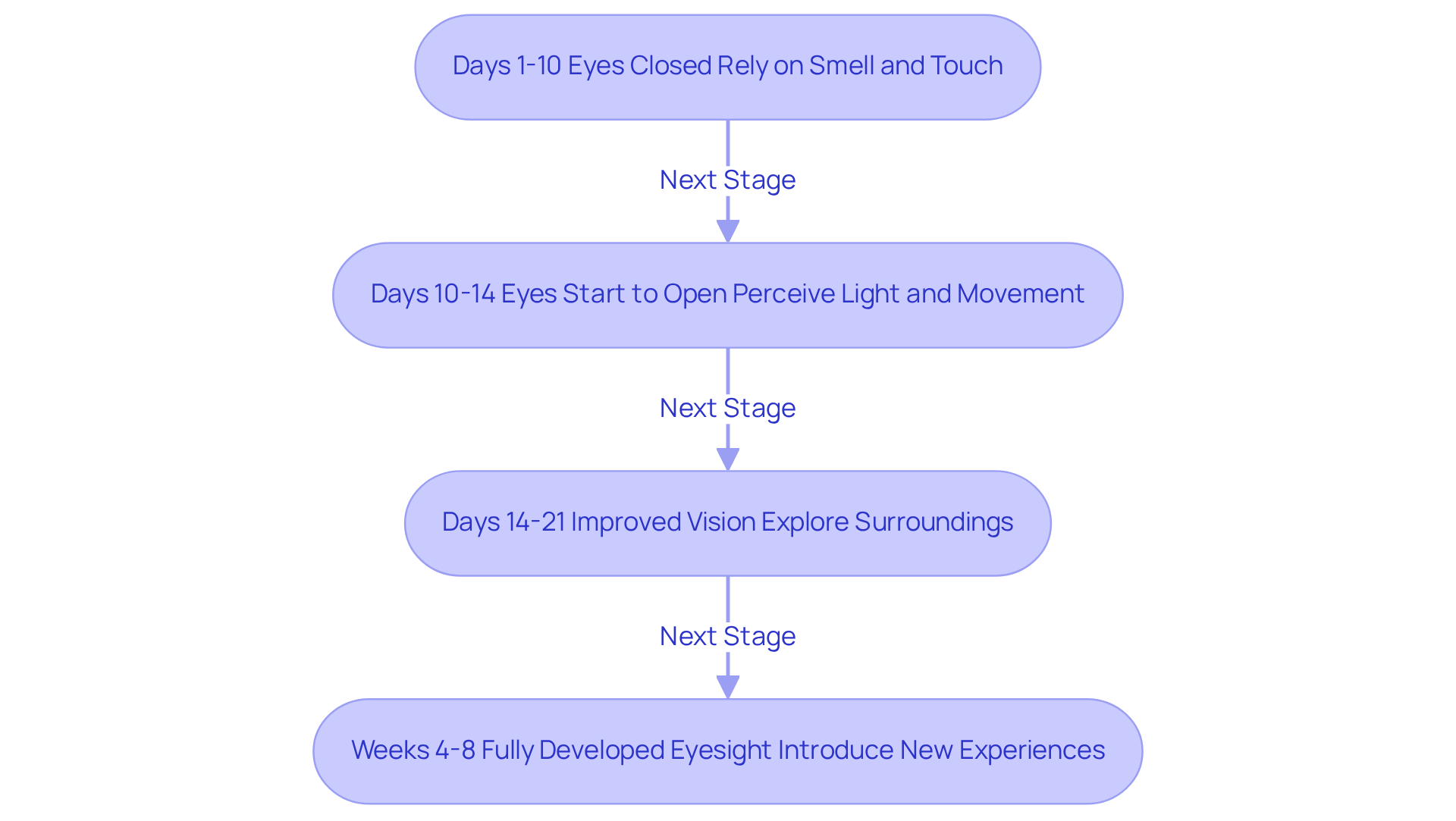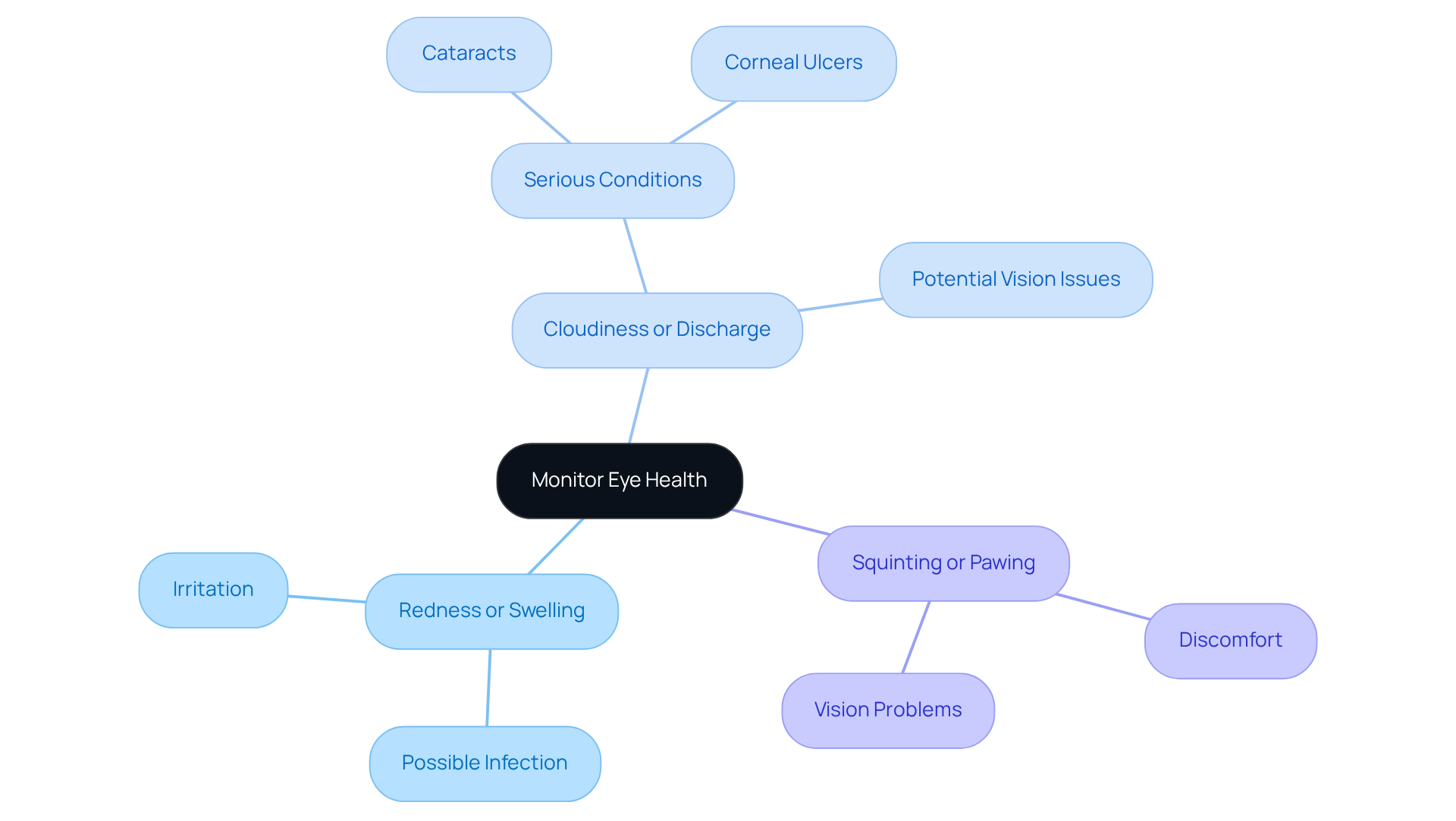
When Do Puppies Open Their Eyes? Key Stages and Timeline
Overview
As loving pet owners, it’s natural to feel concerned about your puppy’s development, especially when it comes to their precious little eyes. Puppies typically open their eyes between 10 to 14 days after birth, and during this time, they initially perceive only light and movement. This gradual process can be a source of anxiety for many, as you might wonder if everything is progressing as it should. By around 8 weeks of age, however, their vision becomes much clearer, allowing them to explore their world more fully.
This timeline highlights a critical stage in your puppy’s growth, underscoring the importance of monitoring their eye health closely. Any delays in eye opening can be worrisome, and it’s essential to know that seeking veterinary consultation can provide peace of mind. Remember, you are not alone in this journey; many pet owners share similar concerns, and there are compassionate solutions available to ensure your furry friend’s well-being. Your puppy’s health is a priority, and taking proactive steps can make all the difference in their development and happiness.
Introduction
Puppies enter the world in a cocoon of darkness, their eyes sealed shut—a protective measure that ensures their safety during those fragile early days. For pet owners, the anticipation of witnessing their puppy’s first glimpse of the world is an emotional journey, typically unfolding between 10 to 14 days after birth.
As these tiny creatures begin to open their eyes, they embark on a critical developmental phase that not only enhances their perception of the environment but also deepens the bond with their caregivers. However, what happens if a puppy’s eyes remain closed beyond the expected timeline? This can be a source of concern for many loving pet owners.
Understanding the stages of eye development and recognizing potential issues is essential for ensuring that every puppy can embark on their visual adventure with health and happiness. Remember, you are not alone in this journey; there are compassionate resources available to help guide you through any challenges that may arise.
Understand Puppy Eye Development Stages
Puppies enter the world with their eyes tightly shut, a natural protective mechanism that ensures their safety during the early days. As a caring pet owner, you might wonder when your little one will start to see the world. Typically, the question of when do puppies open their eyes can be answered as being between 10 to 14 days after birth. Initially, their eyes may look cloudy or bluish, and they can only perceive movement and shapes. This can be a poignant time, as you may feel a mix of anticipation and concern for their well-being.
As the days pass, by the end of the second week, you’ll notice a wonderful transformation—your puppy’s vision starts to improve, allowing them to sense their environment more effectively. This gradual enhancement is a crucial part of their development, and it’s heartwarming to witness. By around 8 weeks of age, complete vision forms, and your young dog can see clearly, beginning to engage more with their surroundings. Understanding these stages not only helps you support your puppy’s growth but also deepens the bond you share. Providing appropriate stimulation and care during this critical period is essential, and it’s reassuring to know that you’re playing a vital role in their journey to seeing the world clearly.

Follow the Timeline for Eye Opening
The timeline for a puppy’s eye opening generally follows this pattern:
-
Days 1-10: When puppies are born, their eyes are closed, and they rely on their senses of smell and touch to navigate their new world. This early stage can be a time of uncertainty for both the puppy and their caregivers, as the little ones depend on their nurturing environment.
-
Days 10-14: When do puppies open their eyes? They begin to perceive light and movement as their eyelids start to open. This period is crucial for socialization, as they begin to recognize their littermates and caregivers. It’s heartwarming to know that all young dogs have blue eyes during this stage, adding to their charm.
-
Days 14-21: By the end of this third period, young dogs can see more distinctly, although their vision remains somewhat limited. They start to explore their surroundings more actively, marking a significant developmental milestone. If a young dog hasn’t opened its sight organs by fourteen days of age, it’s essential to consult a veterinarian, as this raises the question of when do puppies open their eyes and may indicate a developmental delay. Your concern for their well-being is paramount during these early days.
-
Weeks 4-8: Vision continues to improve, and by eight weeks, young dogs should have fully developed eyesight, allowing them to see details and colors. This stage is perfect for introducing them to new experiences and environments, fostering their socialization and confidence. Additionally, consistently cleaning any discharge from around a young dog’s eyes with boiled and cooled water is advised to preserve their visual health. Caring for their needs during this time will help them thrive.

Monitor Eye Health and Seek Veterinary Guidance
As young dogs develop, it’s vital to keep a watchful eye on their eye health. We understand that as a pet owner, you might feel anxious about any signs that could indicate a problem. Key signs to monitor include:
- Redness or swelling: These symptoms may suggest an infection or irritation that needs immediate attention.
- Cloudiness or discharge: Any unusual discharge or persistent cloudiness should prompt a visit to the veterinarian, as these can signal serious conditions.
- Squinting or pawing at the eye: Such behaviors often indicate discomfort or potential vision issues.
If you notice any of these symptoms, please don’t hesitate to consult a veterinarian. Regular veterinary check-ups are also essential to ensure your dog’s eyes are developing correctly and to catch any issues early on. This proactive approach not only supports your dog’s health but significantly enhances their overall quality of life. Statistics show that early detection and treatment of eye conditions can prevent complications like blindness, highlighting the importance of being attentive to these signs. By prioritizing eye health, you can help ensure your puppy enjoys a happy and healthy life, surrounded by the love and care they deserve.

Conclusion
Puppy eye development is a remarkable journey that unfolds over the first few weeks of life, beginning with their eyes closed and gradually progressing to full sight. Understanding when puppies open their eyes, typically between 10 to 14 days after birth, is crucial for pet owners eager to support their furry companions through this vital stage. As their vision develops, so does their ability to engage with the world around them, creating an enriching experience for both the puppy and their caregiver.
Throughout this journey, key stages of eye development are highlighted, emphasizing the importance of monitoring health and seeking veterinary guidance when necessary. From the initial reliance on smell and touch to the gradual opening of their eyes and the eventual clarity of vision by eight weeks, each milestone presents an opportunity for socialization and exploration. Awareness of potential eye health issues, such as redness, cloudiness, or discomfort, is essential to ensure the well-being of the puppy during this formative period.
Ultimately, nurturing a puppy’s eye health is not just about ensuring they can see; it is about fostering a bond and providing the best possible start to their life. By being attentive and proactive, pet owners play a critical role in their puppy’s development, ensuring they grow into healthy, happy dogs ready to embrace the world. Embrace this journey with care and love, and witness the joy that unfolds as your puppy begins to explore their surroundings with newfound sight.
